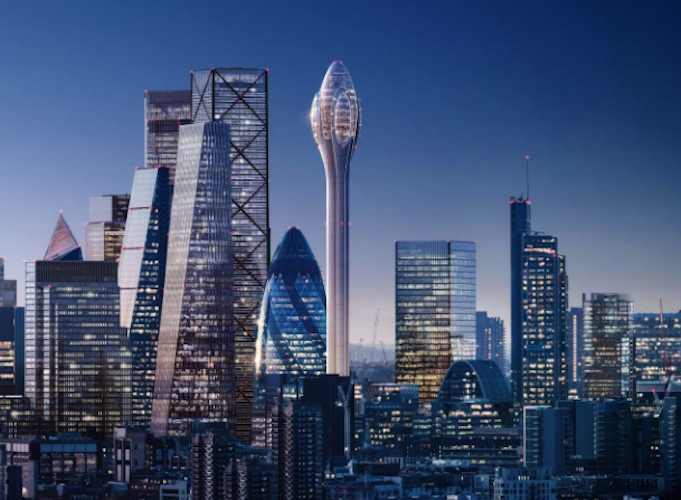Will the Tulip ever take root in EC3? The controversial 305 metre visitor attraction designed by Foster and Partners looks set to pass its first hurdle next week, with planners recommending approval to the City of London Corporation planning committee on 2 April 2. But doing will put it on collision course with Sadiq Khan.
Adjacent to the Gherkin in Bury Street in the heart of the Square Mile, the structure would be the tallest in the City and just five metres shorter than London’s tallest building, the Shard at London Bridge. Its slender concrete stem would be topped by 12 storeys of viewing platforms, restaurants, a bar and an education centre, with gondola pods offering rides around its facade.
The planners’ report concludes that the benefits of the proposal for tourism and education outweigh its negative impact particularly on the setting and significance of the Tower of London World Heritage Site. Revised plans following initial criticism will see provision for 40,000 London “state school” children to visit free of charge every year, and the Tulip would attract 1.2 million visitors annually, boosting London’s economy by almost £1 billion by 2045 and complementing the Corporation’s “Culture Mile” and 24/7 City aspirations.
Permission next week would come in the face of opposition from Historic England, Tower of London managers Historic Royal Palaces and, crucially, the London Mayor, whose powers enable him to direct the Corporation to reverse its decision or to take over the application process himself. City Hall has previously described the height of the structure as “unjustified” and its “solid and inactive building frontage” as “incongruous”. And Khan’s planners also condemned its lack of “free to enter publicly accessible viewing areas”.
City Corporation planners encourage free to enter roof spaces in tall buildings, and claim significant success, including Sky Garden at the “Walkie Talkie” and the recently opened Garden at 120 in Fenchurch Street, as well as the less elevated terrace at the One New Change centre overlooking St Paul’s Cathedral.. Tall buildings in the pipeline in Bishopsgate, Leadenhall Street and at 1 Undershaft all include free public roof space, and the Corporation’s new draft local plan, City Plan 2036, requires publicly accessible, free to enter areas at upper levels in all new tall building proposals.
The Corporation’s argument that the Tulip’s educational provision meets free public access requirements is a major point of contention for City Hall. GLA representations describe the proposal’s public benefits as falling “substantially short of anything appropriate” and insufficient to outweigh harm to the setting of the Tower of London.
Will Khan’s arguments for free access hold up at what seems likely to be an inevitable public planning inquiry, given that the fundamental raison d’etre of the Tulip is as a paid-for visitor attraction?
The argument that London, with one in seven jobs dependent on tourism, needs to continually renew its visitor offer remains strong. This was put forcefully by New London Architecture chair Peter Murray when the Tulip plans were first unveiled: “If London is to keep its place at the top of the league of most visited global cities, particularly in a post-Brexit world, new attractions such as the Tulip are going to be vital for the capital’s culture and economy.”
Nevertheless, under direction not only from Mayor Khan but from the City Corporation as well, the balance between private and public spaces is shifting. Will the Tulip end up on the right side of the argument?

